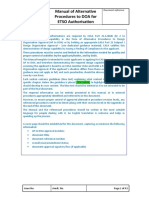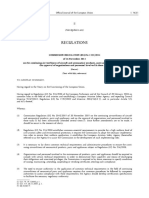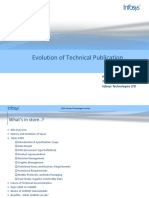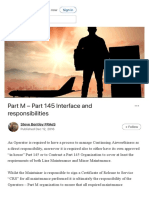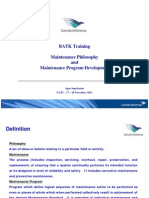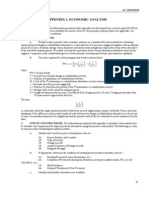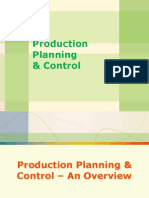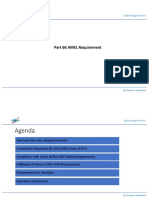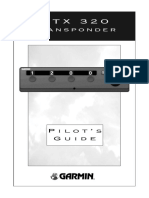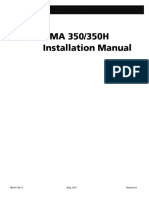AMC-030 Aircraft Parts Handling
AMC-030 Aircraft Parts Handling
Uploaded by
nelson vasquezCopyright:
Available Formats
AMC-030 Aircraft Parts Handling
AMC-030 Aircraft Parts Handling
Uploaded by
nelson vasquezCopyright
Available Formats
Share this document
Did you find this document useful?
Is this content inappropriate?
Copyright:
Available Formats
AMC-030 Aircraft Parts Handling
AMC-030 Aircraft Parts Handling
Uploaded by
nelson vasquezCopyright:
Available Formats
Aircraft Parts Handling (AMC) AMC-030
AMC 030 –AIRCRAFT PARTS HANDLING
CONTENTS 1
CHAPTER 1 Introduction 2
CHAPTER 2 Reporting of unapproved parts 2
2.1 Approved parts
2.2 Unapproved parts
2.3 Supporting Documentation
2.4 Extra precautions to prevent the inadvertent acceptance
of unapproved parts
2.5 Unapproved parts reporting
CHAPTER 3 Removal of parts from aircraft no longer in service 4
CHAPTER 4 Disposal of scrapped parts 5
CHAPTER 5 Parts recovered from aircraft involved in accidents 6
CHAPTER 6 Other industry guidelines 6
APPENDIX 1 Suspected unapproved parts report 7
© Aruba Department of Civil Aviation August, 12
Create: 8/27/2010 10:26:00 AM Page 1 of 8 Update: 8/27/2012 4:28:00 PM
Aircraft Parts Handling (AMC) AMC-030
CHAPTER 1 Introduction
The purpose of this AMC is to provide guidance to Operators and Maintenance Organization to
guarantee that:
- all materials used in those parts of an aircraft which are essential for its safe operation shall
conform to approved specifications, and that those specifications shall be such that materials
accepted as complying with them shall have the essential properties assumed in the design;
- the parts installed on an aircraft meet the design specification and are serviceable at
installation. The installation of any part failing to meet the intended design requirements
degrades those requirements, leading to a degradation of airworthiness;
- for the purposes of airworthiness, a system of control exists which ensures that only parts
meeting the approved design data applicable to a particular aircraft are installed on that
aircraft.
AUA-RLW (A.B. 1995 no. 71, gewijzigd bij A.B. 2000 no. 58), articles 43 and 49 requires
owners, operators and/or maintenance organization to maintain the aircraft in an airworthy
condition.
CHAPTER 2 Reporting of unapproved part
This chapter has been divided into several paragraphs in order to meet its purpose which is the
reporting of unapproved parts.
2.1 Approved parts
a) An approved parts is one meeting approved design data applicable to that part and which has
been manufactured and subsequently maintained in accordance with the requirements of the
State of Design, manufacture or Registry, as applicable.
b) Standard parts such as fasteners are considered as approved parts when in accordance with a
national or industry accepted standard and when referenced in the type design of the particular
aircraft.
2.2 Unapproved parts
Parts not meeting the criteria described in 2.1(a) and (b) are considered to be unapproved.
Unapproved parts also include those parts improperly returned to service, for example:
a) Parts supplied directly to the user by a subcontractor not entitled to do so;
b) Parts maintained or approved for return to service by a person or organization not approved to
do so;
c) Parts not maintained in accordance with the requirements of the applicable approved data; and
d) Parts which have reached their life limit, including, if applicable, any shelf-life limit;
© Aruba Department of Civil Aviation August, 12
Create: 8/27/2010 10:26:00 AM Page 2 of 8 Update: 8/27/2012 4:28:00 PM
Aircraft Parts Handling (AMC) AMC-030
2.3 Supporting documentation
Parts users must implement a documentation process which will have to provide written evidence of
the acceptability of a part. This is an essential element of any system designed to ensure that only
approved parts are installed on an aircraft. Such a process is must provide all relevant information
concerning the part to which it refers to. This must enable the installer to readily ascertain its status.
DCA of Aruba allows installers to use certain documents as long the State of design and/or the
operation standard is defined by the operator/installer. Such documents (for example INS-4.104, FAA
Form 8130-3, EASA Form 1 and TCCA 24-0078) must contain information relating to:
1) The authority under which it is issued;
2) Reference identification for the purpose of traceability;
3) Name, address and approval reference of the issuing organization;
4) Work order, contract or invoice number;
5) Quantity, description, part number and, if applicable, serial number of the part
6) Relevant information concerning any life limitations, compliance or non-compliance with any
airworthiness directives, etc.;
7) The signature and approval reference of the person issuing the document; and
8) Whether the part is new or used;
The procedures for how to apply the forms are mentioned in:
INS-4.104: AMC-029, latest revision
FAA 8130-3: Order 8130-21C, latest revision
EASA Form 1: Part M, Appendix II, latest revision
TCCA 24-0078: CAR 509
Any part not accompanied by the appropriate documentation would be considered to be unapproved.
2.4 Extra precautions to prevent the inadvertent acceptance of unapproved parts
The documentary evidence of compliance as mentioned in paragraph 2.3 will not in it self provide
guarantee against installation of unapproved parts if the original supplier of such parts knowingly
provides false information or otherwise set out to deceive.
That is why maintenance organizations and operators must have secondary defences in place designed
to give early warning of unapproved parts prior to their release for fitment. The main defence in such
cases is a strong, well-informed and alert parts ordering and receiving system which, through auditing
and reports, establishes a satisfactory level of confidence in its parts suppliers and which:
1) Ensures a continual correlation between parts ordered and parts received;
2) Is alert to any unauthorized alterations to supporting documentation and to any inability of the
supplier to supply the required documentation;
3) Is aware if a quoted price for the part is significantly lower than that quoted by other suppliers;
© Aruba Department of Civil Aviation August, 12
Create: 8/27/2010 10:26:00 AM Page 3 of 8 Update: 8/27/2012 4:28:00 PM
Aircraft Parts Handling (AMC) AMC-030
4) Is aware that delivery times are significantly shorter than those quoted by other suppliers;
5) Is aware of parts packaging methods used by approved parts manufacturers, maintenance
organization and distributors, and can detect deviations from these methods;
6) Ensure that all those staff that have routine contact with parts, especially buyers, stores,
mechanics and certifying staff, are fully aware of the dangers posed by unapproved parts and
also the likely sources. Ample warnings should be given to such staff about accessing any
unapproved parts database;
7) ensure that their parts suppliers are fully integrated into the reporting network; and
8) Audits are conducted at intervals to ensure that all remain vigilant to the problem;
2.5 Unapproved parts reporting
The purpose of this paragraph is to instruct all parts users in how to report suspected unapproved
parts. That is why the DCA of Aruba has implemented this standardized reporting format.
Refer to appendix 1 to this AMC for further guidance.
CHAPTER 3 Removal of parts from aircraft no longer in service
Aircraft withdrawn from service are often used as source of spare parts, a process sometimes
described as “parting out”. These parts, although serviceable at the time the aircraft was placed in
storage conditions, including especially environmental factors, or by the length of storage.
It is important that the part removal process be planned and controlled in a manner as close as
possible to that adopted for routine maintenance tasks on in-service aircraft. The following points
in particular must be adhered to:
1) Aircraft must be registered in Aruba;
2) Prior removal of the parts aircraft must be in an airworthy condition;
3) An Aircraft Maintenance Bridging Program must have been developed and accepted by the
DCA of Aruba;
4) The means by which the part is removed should be in accordance with the Aircraft
Maintenance Manuals and using the specified tooling;
5) Adequate access equipment should be provided;
6) If conducted in the open, disassembly should cease during inclement weather;
7) All work should be carried out by appropriately qualified maintenance personnel;
8) All open connections should be blanked;
9) A protected and enclosed quarantine storage area for the parts being removed should be
provided in the immediate vicinity of the work area;
10) Identification tag must be attached to the part;
11) Parts without latest and current FAA 8130-3 or EASA form 1, whichever is applicable must be
sent to an authorized organization for recertification. An assessment for condition and eventual
return to service of each removed part will need to be conducted by this organization. The
© Aruba Department of Civil Aviation August, 12
Create: 8/27/2010 10:26:00 AM Page 4 of 8 Update: 8/27/2012 4:28:00 PM
Aircraft Parts Handling (AMC) AMC-030
extent of the work necessary before the part is returned to service ranges from a simple
external visual inspection to a complete overhaul.
12) The Aruba Airport Authority must be informed accordingly prior commencement of the work
in connection with airframe that will be left behind;
CHAPTER 4 Disposal of scrapped parts
This section of the AMC provide guidance in how to dispose of scrapped parts by aircraft owners,
maintenance organization, operators, etc…
Those responsible for the disposal of scrapped aircraft parts and materials should consider the
possibility of such parts and materials being misrepresented and sold as serviceable at a later date.
Caution should be exercised to ensure that the following types of parts and materials are disposed
of in a controlled manner that does not allow them to be returned to service:
1) Parts with non-repairable defects, whether visible or not to the naked eye;
2) Parts that are not within the specifications set forth by the approved design, and cannot be
brought into conformity with applicable specifications;
3) Parts and materials for which further processing or rework cannot make them eligible for
certification under an approved system;
4) Parts subjected to unacceptable modifications or rework that is irreversible;
5) Life-limited parts that have reached or exceeded their life limits, or have missing or
incomplete records;
6) Parts that cannot be returned to an airworthy condition due to exposure to extreme forces or
heat;
7) Principal structural elements removed from a highcycle aircraft for which conformity cannot
be accomplished by complying with the mandatory requirements applicable to aging aircraft;
Scrapped parts should always be segregated from serviceable parts and when eventually disposed
of should be mutilated or clearly and permanently marked. This should be accomplished in such a
manner that the parts become unusable for their original intended use and unable to be reworked
or camouflaged to provide the appearance of being serviceable.
When scrapped parts are disposed of for legitimate non-flight uses, such as training and education
aids, research and development, or for non-aviation applications, mutilation is often not
appropriate. In such cases the parts should be permanently marked indicating that they are not
serviceable; alternatively, the original partnumber or data plate information must be removed or a
record kept of the disposition of the parts.
© Aruba Department of Civil Aviation August, 12
Create: 8/27/2010 10:26:00 AM Page 5 of 8 Update: 8/27/2012 4:28:00 PM
Aircraft Parts Handling (AMC) AMC-030
CHAPTER 5 Parts recovered from aircraft involved in accidents.
It is prohibited to re-use affected aircraft parts directly involved in an accident or incident.
In other cases some items may be totally unaffected by the accident or incident which caused the
aircraft to be declared as salvage, it is essential to obtain clear evidence that this is the case. If such
evidence cannot be obtained, the item may not be returned to service.
Before overhaul and reinstallation can be considered, all such items must therefore be subject to
competent assessment and inspection in the light of adequate knowledge of the circumstances of
the accident, subsequent storage and transport conditions, and with evidence of previous
operational history obtained from valid airworthiness records. Confirmation of this assessment
must be in the form of an airworthiness release.
Parts to be rejected are those whereby:
1. the crash load may have took the part above its proof strength;
2. change of material characteristics in a part due to overheat ;
It is very important to establish that the part is not cracked, distorted or overheated. If the installer
is unable to officially establish this than the part must be rejected.
CHAPTER 6 Other industry guidelines.
Since Aruba does not have any aircraft manufacturers for aircraft, aircraft engines, propeller and
any other aircraft parts, other industry guidelines must be consulted. These are:
1. FAA Order 8120.16, 8120.2
2. FAA AC 20-62D, 21-20B, 21-29C, 43-18
3. 14 CFR, Part 1, 21, 43, 91 AND 145;
4. EASA Part-M, Part-M-AMC, Part-21, Part 145
© Aruba Department of Civil Aviation August, 12
Create: 8/27/2010 10:26:00 AM Page 6 of 8 Update: 8/27/2012 4:28:00 PM
Aircraft Parts Handling (AMC) AMC-030
APPENDIX 1. SUSPECTED UNAPPROVED PARTS REPORT
SUSPECTED UNAPPROVED PARTS REPORT
DIRECTIE LUCHTVAART ARUBA
DEPARTMENT OF CIVIL AVIATION ARUBA FORM INS-4.106
REFER TO PAGE 2 FOR INSTRUCTIONS ON HOW TO COMPLETE THIS FORM
1. Date the Part was discovered: 2. Part name:
3. Part number: 4. Part Serial number:
5. Quantity: 6. Assembly name: 8. Aircraft make & model:
7. Assembly number:
9. Name, Address, and Description of the Company or Person who supplied or repaired the Part:
Name: Street Address:
City: State: ZIP Code:
Country: Phone numbers:
Check One of the Following applicable to the Company or person who supplied or repaired the part:
□ AOC Holder – Certificate #: □ Supplier:
□ Mechanic – Certificate #: □ Production Approval Holder:
□ Maintenance Organization – Certificate #: □ Manufacturer:
□ Distributor: □ Other:
□ Owner/Operator: □ Unknown
10. Description of the Issue:
11. Name and address of (the company or person) where the Part was discovered:
Name: Street Address:
City: State: ZIP Code:
Country: Phone numbers:
Check one of the following applicable to the company or person who discovered the Part:
□ AOC Holder – Certificate #: □ DCA Inspector:
□ Mechanic – Certificate #: □ Ministry of Tourism, Transport and Labour
□ Maintenance Organization – Certificate #: □ Foreign Civil Aviation Authority:
□ Distributor: □ Owner/Operator:
□ Supplier: □ Other
□ Production Approval Holder:
12. Date of this report:
13. □ Check this box if you request anonymity – Do not complete blocks 14 – 16
14. Name and Address of the reporter
Name: Street Address:
City: State: ZIP Code:
Country: Phone numbers:
15. □ Check this box if you request confidentiality.
16. □ Check this box if you have attached additional information.
Page 1 of 2
Revision: 00 Date: 1 September 2010
© Aruba Department of Civil Aviation August, 12
Create: 8/27/2010 10:26:00 AM Page 7 of 8 Update: 8/27/2012 4:28:00 PM
Aircraft Parts Handling (AMC) AMC-030
Instructions for completing DCA FORM INS-4.106: SUSPECTED UNAPPROVED PARTS REPORT
1. Enter the date the part was discovered;
2. Enter the name of the part (or a description of the part);
3. Enter the part number or identification number of the part;
4. Enter the serial number on the part, if applicable;
5. Enter the quantity of parts;
6. Enter the assembly name;
7. Enter the assembly number;
8. Enter the aircraft make & model it applies to;
9. Enter complete name and address of the company or person who produced, repaired, and/or sold the part. Do not
list a P.O. Box unless a street address is not available;
AOC Holder: A DCA certified airline Supplier: A company or person who finishes aircraft parts
or related services to the producer of a product or part
thereof
Mechanic: A person holding a DCA AME license or Production Approval Holder: A company or person holding
validation: one of the following four types of production approvals:
production certificate, approved production inspection
system, parts manufacturer approval, or technical standard
order authorization.
Maintenance Organization: A DCA approved, accepted or Manufacturer: The original equipment manufacturer (OEM)
validated organization to conduct maintenance.
Distributor: A broker, dealer, reseller, or other person or Other: Enter any other type of business.
agency engaged in the sale of parts.
Owner/Operator: The owner or operator of an aircraft. Unknown:
10. Enter a brief narrative stating why you believe the part is not approved. Include a description of the part
(improper configuration, suspect marking, different material, etc.), where it was obtain and what type of
documentation was supplied with it.
11. Enter complete name and address of the location where the part was found. Check the appropriate block to reflect
the affiliation of the company or person who discovered the part;
12. Enter the date the DCA FORM INS-4.106 is being submitted;
13. Check the box if you request anonymity (do not wish to provide your identity), and do not complete 14 or 15;
14. Enter your name, address and phone number, if desired. This information will enable the DCA to contact you for
additional information, if necessary;
15. Check this box if you request confidentiality of your personal information recorded in block 13;
16. Check this box if you have attached additional information (photos, invoices, certification statements, etc.)
Send the completed FORM INS-4.106, SUSPECTED UNAPPROVED OARTS REPORT, to:
Department of Civil Aviation Aruba
Sabana Berde 73-B
Oranjestad
Aruba
dca@aruba.gov.aw
Page 2 of 2
Revision: 00 Date: 1 September 2010
© Aruba Department of Civil Aviation August, 12
Create: 8/27/2010 10:26:00 AM Page 8 of 8 Update: 8/27/2012 4:28:00 PM
You might also like
- LS FMD HandbookDocument6 pagesLS FMD HandbookTrevNo ratings yet
- I 485 Cabrera Alonso, MeidelynDocument18 pagesI 485 Cabrera Alonso, MeidelynMeidelyn CabreraNo ratings yet
- Manual of Alternative Procedures To DOA For ETSO AuthorisationDocument42 pagesManual of Alternative Procedures To DOA For ETSO AuthorisationAlain Francois100% (1)
- F Maintenance Program Planning ServicesDocument272 pagesF Maintenance Program Planning ServicesFais100% (1)
- CASR Part 147 Amdt. 0 - Approved Maintenance Training OrganizationDocument20 pagesCASR Part 147 Amdt. 0 - Approved Maintenance Training OrganizationarifNo ratings yet
- Dimensions of CFM Shipping Stands - 1 PDFDocument2 pagesDimensions of CFM Shipping Stands - 1 PDFHerix FerrerNo ratings yet
- FAA Order 8900.1 CHG 218Document5 pagesFAA Order 8900.1 CHG 218Muhammad Ashraful KabirNo ratings yet
- Steady Aircraft Flight and PerformanceFrom EverandSteady Aircraft Flight and PerformanceRating: 5 out of 5 stars5/5 (2)
- Stanadyne db2435 4942Document4 pagesStanadyne db2435 4942nelson vasquezNo ratings yet
- Stanadyne db2435 4942Document4 pagesStanadyne db2435 4942nelson vasquezNo ratings yet
- Assessment METCCaseStudy1Document2 pagesAssessment METCCaseStudy1sharlotrajsliNo ratings yet
- DGCA-AC 21-29 Amdt. 1 - Detecting and Reporting Suspected Unapproved PartsDocument10 pagesDGCA-AC 21-29 Amdt. 1 - Detecting and Reporting Suspected Unapproved Partsraihan zakyNo ratings yet
- Aerospace Actuators 1: Needs, Reliability and Hydraulic Power SolutionsFrom EverandAerospace Actuators 1: Needs, Reliability and Hydraulic Power SolutionsNo ratings yet
- AC 04006 Reliability CAAV A2009EDocument12 pagesAC 04006 Reliability CAAV A2009EThanh Hao LuongNo ratings yet
- Table of ContentsDocument27 pagesTable of ContentsDipendra SenNo ratings yet
- 111.wheels and BrakesDocument94 pages111.wheels and BrakesTalita CumiNo ratings yet
- Aircraft MaintenanceDocument5 pagesAircraft MaintenanceMussa LucasNo ratings yet
- A00006WIDocument8 pagesA00006WISantosa Edy WibowoNo ratings yet
- 13 Etops-MspencerDocument19 pages13 Etops-MspencerByungsun ChoiNo ratings yet
- CAME Issue-1 Rev 4 - May-2023Document443 pagesCAME Issue-1 Rev 4 - May-2023Benzeer TanhaNo ratings yet
- A320 & A319 Recurent Course SyllabusDocument2 pagesA320 & A319 Recurent Course SyllabusMustafa AssadiNo ratings yet
- Regulation 1321 2014 On The Continuing Airworthiness of Aircraft en PDFDocument194 pagesRegulation 1321 2014 On The Continuing Airworthiness of Aircraft en PDFmechNo ratings yet
- Guide: Training Course On Aircraft Maintenance Program A320 FamilyDocument3 pagesGuide: Training Course On Aircraft Maintenance Program A320 FamilyZ.i. HamidiNo ratings yet
- AC 120-49 Amdt 0Document31 pagesAC 120-49 Amdt 0matalangNo ratings yet
- Resume FOR AMEDocument3 pagesResume FOR AMERohit RizalNo ratings yet
- Blank Ca Form 1Document1 pageBlank Ca Form 1Vangala SuneethaNo ratings yet
- 6-Evolution of Technical Publications FulsungeDocument23 pages6-Evolution of Technical Publications FulsungeYeshwanth Kumar100% (1)
- CASPSS-LEAP-June 2017Document44 pagesCASPSS-LEAP-June 2017Byungsun ChoiNo ratings yet
- Aircraft Centre Tank (ACT) Fuel LeakDocument3 pagesAircraft Centre Tank (ACT) Fuel LeakpannNo ratings yet
- Part M and 145 InterferenceDocument5 pagesPart M and 145 InterferenceMohamad AbuhayyehNo ratings yet
- PART-147 Approved Training Organisations: Q.C.M. Revision No.: 1 Date: 01 March 2012Document74 pagesPART-147 Approved Training Organisations: Q.C.M. Revision No.: 1 Date: 01 March 2012mahmud517100% (1)
- UG - CAO.00014 Foreign Part 147 Approvals User Guide For MTOEDocument70 pagesUG - CAO.00014 Foreign Part 147 Approvals User Guide For MTOEDiana DumitracheNo ratings yet
- Part 66 Basic Practical Experience LogbookDocument43 pagesPart 66 Basic Practical Experience LogbookAlanNo ratings yet
- WATOGDocument73 pagesWATOGGeovanni Riquelme LooNo ratings yet
- ChecklistDocument2 pagesChecklistM. SaadNo ratings yet
- Maint Philsp N Devlp ProgrDocument47 pagesMaint Philsp N Devlp Progrhatach100% (1)
- CAAN NCAR 147 GuidelineDocument55 pagesCAAN NCAR 147 GuidelineAbhishek Man ShresthaNo ratings yet
- Daily CheckDocument5 pagesDaily Checkasad ullahNo ratings yet
- CAAT ENG 01 Aircraft Maintenance Schedules and Programmes SignedDocument40 pagesCAAT ENG 01 Aircraft Maintenance Schedules and Programmes Signedjakara tongchimNo ratings yet
- CASR Part 145: Manual No.: BCT-0044 For Training Purpose Only Rev. 1: Sep 09, 2019Document47 pagesCASR Part 145: Manual No.: BCT-0044 For Training Purpose Only Rev. 1: Sep 09, 2019Eka Putra SangajiNo ratings yet
- MoeDocument214 pagesMoemahmud517No ratings yet
- Nepal Civil Aviation Regulation Part 66 ManualDocument194 pagesNepal Civil Aviation Regulation Part 66 ManualAbhishek Man ShresthaNo ratings yet
- ETSO-C127a CS-ETSO 0Document6 pagesETSO-C127a CS-ETSO 0Anurag MishraNo ratings yet
- Atr 72-NDT20-00-01 Rev0Document22 pagesAtr 72-NDT20-00-01 Rev0lightjp1No ratings yet
- Receiving Inspections Power Point 10-22-16Document52 pagesReceiving Inspections Power Point 10-22-16Darby Morgan100% (1)
- NPA Part-M GADocument20 pagesNPA Part-M GAAnanda MandalNo ratings yet
- Maintenence Economic AnalysisDocument26 pagesMaintenence Economic AnalysisSameer SawantNo ratings yet
- Operations Management: Production Planning & ControlDocument22 pagesOperations Management: Production Planning & ControlAnosh DoodhmalNo ratings yet
- Ac 00-65Document8 pagesAc 00-65Santiago QuinapantaNo ratings yet
- S P SinghDocument25 pagesS P SinghManish MishraNo ratings yet
- Operator E-Jets News Rel 040Document12 pagesOperator E-Jets News Rel 040jivomirNo ratings yet
- Capability List SAATDocument344 pagesCapability List SAATMohsen PeykaranNo ratings yet
- ATA70standard Practice EngineDocument24 pagesATA70standard Practice EnginearunNo ratings yet
- Aircraft Records: Click Here For An Example of How To Prepare The RecordsDocument5 pagesAircraft Records: Click Here For An Example of How To Prepare The RecordsHaliunaa BatboldNo ratings yet
- Guide To Out of Phase Tasks and MaintenaceDocument1 pageGuide To Out of Phase Tasks and MaintenacesaradeepsNo ratings yet
- Tai Easa Part 147 Mto (Part 66 Required)Document38 pagesTai Easa Part 147 Mto (Part 66 Required)Chatchai PrasertsukNo ratings yet
- Technical Standard Order: TSO-C126cDocument7 pagesTechnical Standard Order: TSO-C126crdpereirNo ratings yet
- An Airline Maintenance Manpower PlanningDocument14 pagesAn Airline Maintenance Manpower Planninga_sharafiehNo ratings yet
- ANO M GuidanceDocument30 pagesANO M GuidanceZain Hasan100% (1)
- GMMDocument228 pagesGMMCristhian342No ratings yet
- DOCUMENTATIONDocument47 pagesDOCUMENTATIONRicell James Adriano100% (2)
- Airworthiness Review Certificate (ARC) Review - IALTADocument1 pageAirworthiness Review Certificate (ARC) Review - IALTAsaksham upadhyayNo ratings yet
- TekkatalogDocument104 pagesTekkatalogKane Adams75% (4)
- Aerospace Actuators V3: European Commercial Aircraft and Tiltrotor AircraftFrom EverandAerospace Actuators V3: European Commercial Aircraft and Tiltrotor AircraftNo ratings yet
- Transponder: Pilot's GuideDocument4 pagesTransponder: Pilot's Guidenelson vasquezNo ratings yet
- Gma 350H InstallationDocument49 pagesGma 350H Installationnelson vasquezNo ratings yet
- Mentoring Best PracticesDocument20 pagesMentoring Best Practicesnelson vasquez100% (1)
- Understanding Engine Color CodesDocument2 pagesUnderstanding Engine Color Codesnelson vasquezNo ratings yet
- Installation Manual: AV-30 Multi-Mode IndicatorDocument17 pagesInstallation Manual: AV-30 Multi-Mode Indicatornelson vasquezNo ratings yet
- Why Take Unnecessary Risks When: You FlyDocument2 pagesWhy Take Unnecessary Risks When: You Flynelson vasquezNo ratings yet
- Safety Tips: Flying Your DroneDocument1 pageSafety Tips: Flying Your Dronenelson vasquezNo ratings yet
- Gi275 Autopilot Compatibility2 PDFDocument1 pageGi275 Autopilot Compatibility2 PDFnelson vasquezNo ratings yet
- Gi275 Autopilot Compatibility2 PDFDocument1 pageGi275 Autopilot Compatibility2 PDFnelson vasquezNo ratings yet
- Gi 275 STC Maintenance ManualDocument120 pagesGi 275 STC Maintenance Manualnelson vasquez100% (1)
- Gi275 Pilots Guide PDFDocument250 pagesGi275 Pilots Guide PDFnelson vasquezNo ratings yet
- Barfield 1811d ManualDocument64 pagesBarfield 1811d Manualnelson vasquezNo ratings yet
- Avionics: Ramp Test SetDocument12 pagesAvionics: Ramp Test Setnelson vasquez100% (1)
- The Kap Autopilot SystemDocument26 pagesThe Kap Autopilot Systemnelson vasquezNo ratings yet
- Saft 203212 Whi Vaseline PDFDocument14 pagesSaft 203212 Whi Vaseline PDFnelson vasquezNo ratings yet
- kx165 and kx155 Brochure PDFDocument6 pageskx165 and kx155 Brochure PDFnelson vasquezNo ratings yet
- Heliport Product Selector PDFDocument19 pagesHeliport Product Selector PDFnelson vasquezNo ratings yet
- Taking Wireless Freedom To A New Level: Tiger Performance Products, IncDocument6 pagesTaking Wireless Freedom To A New Level: Tiger Performance Products, Incnelson vasquezNo ratings yet
- Msa Gallet La100 Flight HelmetDocument14 pagesMsa Gallet La100 Flight Helmetnelson vasquezNo ratings yet
- ترجمه پروانه نظام مهندسیDocument1 pageترجمه پروانه نظام مهندسیhamid dehnavipourNo ratings yet
- Sun Tzu Police BrutalityDocument3 pagesSun Tzu Police BrutalityAlix SwannNo ratings yet
- Ac 43.13-2B 1Document1 pageAc 43.13-2B 1dnanaNo ratings yet
- Practice Paper 1 by KH (HIST)Document2 pagesPractice Paper 1 by KH (HIST)Hassaan AzizNo ratings yet
- Inventory - Gross Profit - Retail MethodDocument6 pagesInventory - Gross Profit - Retail MethodaleywaleyNo ratings yet
- Certifiedaccountsprofessional (Cap) : St. Xavier'S College (Autonomous)Document4 pagesCertifiedaccountsprofessional (Cap) : St. Xavier'S College (Autonomous)michaelcoNo ratings yet
- Western Canadian Shopping Centres Inc. v. Dutton: Supreme Court of CanadaDocument18 pagesWestern Canadian Shopping Centres Inc. v. Dutton: Supreme Court of Canadainefable007No ratings yet
- Tax Law Class NotesDocument126 pagesTax Law Class NotesANAND GEO 1850508No ratings yet
- Security Bank and Trust Company vs. GanDocument2 pagesSecurity Bank and Trust Company vs. GanElaine HonradeNo ratings yet
- Publicatie Investing in BangladeshDocument80 pagesPublicatie Investing in BangladeshShouravpedia™No ratings yet
- PPCRV Voters Ed PPT MakakalikasanDocument40 pagesPPCRV Voters Ed PPT MakakalikasanCreztil Ann GamboaNo ratings yet
- State SocietyDocument20 pagesState SocietyEloisa Micah GuabesNo ratings yet
- Stan - Commodities - PVT - LTD - Vs - Punjab - and - Sind - Bank - A para 20-30Document13 pagesStan - Commodities - PVT - LTD - Vs - Punjab - and - Sind - Bank - A para 20-30juhiNo ratings yet
- Mercado v. Manzano, 307 SCRA 630, 1999Document3 pagesMercado v. Manzano, 307 SCRA 630, 1999ajyu100% (1)
- Donald Trump - WikipediaDocument93 pagesDonald Trump - WikipediaRaskitNo ratings yet
- Application For A Visitor Visa - Sponsored Family Stream: About This Form Visa ValidityDocument17 pagesApplication For A Visitor Visa - Sponsored Family Stream: About This Form Visa ValidityNemo RazalanNo ratings yet
- Gunawan W. - CV ResumeDocument3 pagesGunawan W. - CV Resumeawali.sholihatNo ratings yet
- FM Assignment Khushirani Patel 2141801031Document10 pagesFM Assignment Khushirani Patel 2141801031Tusharkant SwainNo ratings yet
- HajjaAminaAdil MuhammadTheMessengerOfIslam 1 PDFDocument516 pagesHajjaAminaAdil MuhammadTheMessengerOfIslam 1 PDFmezbah100% (3)
- Rights of Shareholders - Study - ImpDocument5 pagesRights of Shareholders - Study - ImpMashfiq SohrabNo ratings yet
- De Minimis BenefitsDocument4 pagesDe Minimis BenefitsGeromil HernandezNo ratings yet
- New Moga Transport Co. v. United India I ..., (2004) 4 SCC 677Document7 pagesNew Moga Transport Co. v. United India I ..., (2004) 4 SCC 677Yati Singh ChAuhanNo ratings yet
- Making of Constitution Important Acts Constitutional Land Mark Important ProvisionsDocument5 pagesMaking of Constitution Important Acts Constitutional Land Mark Important ProvisionsMushini NagabhushanNo ratings yet
- ARC Construction Site Security FFDocument6 pagesARC Construction Site Security FFFara LaguinèdiNo ratings yet
- Difference Between Kidnapping and AbductionDocument8 pagesDifference Between Kidnapping and AbductionJayesh RajputNo ratings yet
- Financial Statement AnalysisDocument303 pagesFinancial Statement AnalysisdkotutNo ratings yet
- Ethics 2Document3 pagesEthics 2OwenNo ratings yet


